Choi, Pak-Kon Professor
 |
To the group homepage
http://www.isc.meiji.ac.jp/~pkchoi/Profsai.html
|
Academic Degree
Pak-Kon Choi received his B.S. from the University of Tokyo in 1974, and his Ph.D. from the University of Tokyo in 1979. He came to Meiji University in 1989 after the experience of research position at the Institute of Industrial Science, the University of Tokyo. He is now a professor of the department of physics, school of science and technology, Meiji University.
|
Membership in Academic Societies
The Acoustical Society of Japan
The Acoustical Society of America
The Japan Society of Applied Physics
The Japan Society of Sonochemistry (executive board member)
The Institute of Electronic, Information and Communication Engineers (senior member)
|
|
Research Interests
(i) Sonoluminescence and Acoustic Cavitation Dynamics
(ii) Physical Ultrasonics
Sonoluminescence is light emission from cavitation bubbles that repeatedly expand and contract in liquid (water, for example) under ultrasonic irradiation. The temperature and pressure inside the bubbles at the final stage of contraction are believed to be over 10,000 K and several hundreds of atm. This extreme condition enables plasma formation, chemical reactions including OH radicals, and shock-wave emission. Our main interest is to study the mechanism of sonoluminescence and relevant bubble dynamics using the techniques of spectroscopy and high-speed photography at a million frames/s. The application of cavitation bubbles is widespread in the fields such as industrial cleaning, environmental chemistry, medical diagnosis and cancer therapy.
 |
|
(Figure caption) Sonoluminescence from KCl aqueous solution contained in a cylindrical cell (left). K-atom emission arises from inside cavitating bubbles under high pressure and high temperature. The K-atom spectra represented by the right-hand figure show line shift and broadening, which provide the values of 580 atm and 3,500 K at the collapse of bubble.
|
References
- 1)
- Y. Hayashi and P.-K. Choi, “Effects of rare-gases on sonoluminescence spectrum of K atom”, J. Phys. Chem. B, 116, 7891-7897, (2012).
- 2)
- P.-K. Choi, “Sonoluminescence of inorganic ions in aqueous solutions” in Theoretical and Experimental Sonochemistry Involving Inorganic Systems eds. Pankaj and M. Ashokkumar, (Springer, 2010) pp.337-356
Surface Wave Properties on Soft Materials
The elasticity of soft materials, such as gelatin gels and biological tissues, is difficult to measure because of its smallness. We have succeeded in measuring the shear elasticity of several gels and porcine liver using surface elastic waves.
 |
|
Surface wave velocity vs temperature in a 5 % gelatin solution.
|
The figure shows the velocity of surface waves propagating on 5% gelatin solution as a function of temperature at frequencies of 250, 500 and 750 Hz. At temperatures higher than 25 degree C the sample exhibits a sol state where surface tension dominates the restoring force of surface waves. At lower temperatures, the sample is in a gel state where shear elasticity dominates the surface waves. Thus, the surface wave properties clearly indicate a sol-gel transition in gelatin.
References
- 1)
- H.Takahashi and P-K. Choi, “Sol-gel transition in gelatin observed with surface waves” Jpn. J. Appl. Phys. 35, pp.2939-2943, (1996).
- 2)
- Y. Onodera and P.-K. Choi, “Surface-wave modes on soft gels”, J. Acoust. Soc. Am. 104, pp.3358-3363, (1998).












